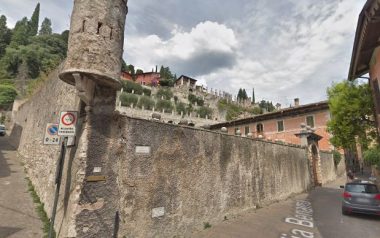Palace Bulgheroni
Palace Bulgheroni – Characteristic architectural elements of the XV-XVI-XVII centuries that are found along the buildings of the historical center of one of the centers of the Magnifica Patria
Palace Bulgheroni: This palace was never part of the complex of the three well-known Gonzaga palaces but, according to our conjecture arose in the margins of them and was built by a wealthy merchant in a happy moment amid two periods of disastrous destruction that led to the almost total disappearance of the buildings of the dukes of Mantua, as we will briefly say. Today this building is surrounded by a high wall, surmounted by large stone balls; in that wall, on the main street (which was the ancient and only communication via land between Toscolano and the upper Riviera), a stone portal opens to flat drafts, covered by a large overhanging granda, supported by shelves and surmounted by three stone balls with supports. On the edge of the boundary wall stands a spy tower supported by shelves, with numerous loopholes. The view towards the south of the villa is simple, it has only a pedestrian portal, which is accessed by a staircase with converging ramps, and, above it, a pot-bellied balcony in wrought iron. But the particular that counts, what really gives a high tone to the noble house is the beautiful band, painted we do not know when, under the eaves of the roof and in which you can see tritons, najadi and other marine deities chasing each other. We add the beautiful tavolesotto the eaves, painted with rosettes and alternating cupids that complete the rich decoration. The north façade faces a courtyard and has three portico spans on the ground floor and five loggia on the first floor, all supported by Tuscan columns, clearly seventeenth-century. In the interior utto has been remodeled: you can not see that two ceilings with painted rafters. Worthy of note is the uphill garden formed by a truncated cone staircase, accompanied by a balustrade that ends with two strange statues. A little further up there are arches with traces of frescoes, then the “gardens” of lemons formed by five storeys or steps overlapping one another along the slopes of the hill begin. Once back on the road, it was not until a few years ago that a portal identical to the one still existing, to give access to the brolo which, at the time of the Gonzaga, certainly extended up to the lake among olive groves. At the time there was neither the road today paved nor all the houses scattered around there.
Palace Bulgheroni – Historical sources Fausto Lechi, “Dimore Bresciane, in cinque secoli di storia”

